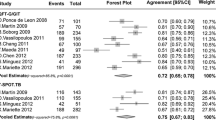Abstract
Triggers of indeterminate results from interferon-gamma release assays (IGRA) in patients with rheumatic diseases are still elusive. The aim of the present study was to describe predictors of indeterminate results from IGRA in the field of rheumatology. This cross-sectional study was retrospectively performed by using a database of patients with a request for QuantiFERON-TB Gold-In Tube test (QFT-GIT) for screening of latent tuberculosis infection. The study cohort included 631 patients with rheumatic diseases. All variables influencing indeterminate QFT-GIT results were investigated by logistic regression analysis. The overall frequency of indeterminate IGRA results was 6.8 % (43/631). Those with indeterminate results were more likely to be aged ≥70 years, female, visitors in winter, suffering from systemic lupus erythematosus (SLE), and using sulfasalazine or a tumor necrosis factor (TNF)-α inhibitor. In addition, a longer incubation time of >6 h increased the odds ratio of indeterminate IGRA results. In contrast, the automated ELISA processor, ankylosing spondylitis, and the use of a non-steroidal anti-inflammatory drug decreased the likelihood of indeterminate IGRA results. Lymphopenia, thrombocytopenia, anemia, and hypoalbuminemia were significantly associated with indeterminate IGRA results. Multivariate analysis revealed that SLE, use of sulfasalazine or a TNF-α inhibitor, and a manual ELISA system were significantly independent predictors of indeterminate IGRA results. The proportion of indeterminate results in patients with rheumatic diseases is not infrequent. Careful attention to the pre-analytical conditions should minimize the indeterminate results. Automation of the ELISA process seems to be a promising solution to decrease the rate of indeterminate response.
Similar content being viewed by others
References
Ponce de Leon D, Acevedo-Vasquez E, Sanchez-Torres A et al (2005) Attenuated response to purified protein derivative in patients with rheumatoid arthritis: study in a population with a high prevalence of tuberculosis. Ann Rheum Dis 64:1360–1361
Pai M, Riley LW, Colford JM Jr (2004) Interferon-gamma assays in the immunodiagnosis of tuberculosis: a systematic review. Lancet Infect Dis 4:761–776
Ledingham J, Wilkinson C, Deighton C (2005) British Thoracic Society (BTS) recommendations for assessing risk and managing tuberculosis in patients due to start anti-TNF-{alpha} treatments. Rheumatology (Oxford) 44:1205–1206
Diel R, Loddenkemper R, Nienhaus A (2010) Evidence-based comparison of commercial interferon-gamma release assays for detecting active TB: a metaanalysis. Chest 137:952–968
Aletaha D, Neogi T, Silman AJ et al (2010) 2010 Rheumatoid arthritis classification criteria: an American College of Rheumatology/European League Against Rheumatism collaborative initiative. Arthritis Rheum 62:2569–2581
van der Linden S, Valkenburg HA, Cats A (1984) Evaluation of diagnostic criteria for ankylosing spondylitis. A proposal for modification of the New York criteria. Arthritis Rheum 27:361–368
Hochberg MC (1997) Updating the American College of Rheumatology revised criteria for the classification of systemic lupus erythematosus. Arthritis Rheum 40:1725
(1990) Criteria for diagnosis of Behcet’s disease. International Study Group for Behcet’s Disease. Lancet 335:1078–1080
Yamaguchi M, Ohta A, Tsunematsu T et al (1992) Preliminary criteria for classification of adult Still’s disease. J Rheumatol 19:424–430
Aabye MG, Ravn P, PrayGod G et al (2009) The impact of HIV infection and CD4 cell count on the performance of an interferon gamma release assay in patients with pulmonary tuberculosis. PLoS ONE 4:e4220
Kobashi Y, Sugiu T, Mouri K et al (2009) Indeterminate results of QuantiFERON TB-2G test performed in routine clinical practice. Eur Respir J 33:812–815
Oni T, Gideon HP, Bangani N et al (2012) Risk factors associated with indeterminate gamma interferon responses in the assessment of latent tuberculosis infection in a high-incidence environment. Clin Vaccine Immunol 19:1243–1247
Beffa P, Zellweger A, Janssens JP et al (2008) Indeterminate test results of T-SPOT.TB performed under routine field conditions. Eur Respir J 31:842–846
Aichelburg MC, Tittes J, Breitenecker F et al (2012) Prognostic value of indeterminate IFN-gamma release assay results in HIV-1 infection. J Clin Microbiol 50:2767–2769
Doherty TM, Demissie A, Menzies D et al (2005) Effect of sample handling on analysis of cytokine responses to Mycobacterium tuberculosis in clinical samples using ELISA, ELISPOT and quantitative PCR. J Immunol Methods 298:129–141
Aabye MG, Hermansen TS, Ruhwald M et al (2012) Negative effect of smoking on the performance of the QuantiFERON TB gold in tube test. BMC Infect Dis 12:379
Papay P, Eser A, Winkler S et al (2011) Predictors of indeterminate IFN-gamma release assay in screening for latent TB in inflammatory bowel diseases. Eur J Clin Invest 41:1071–1076
Dheda K, Lalvani A, Miller RF et al (2005) Performance of a T-cell-based diagnostic test for tuberculosis infection in HIV-infected individuals is independent of CD4 cell count. AIDS 19:2038–2041
Brock I, Ruhwald M, Lundgren B et al (2006) Latent tuberculosis in HIV positive, diagnosed by the M. tuberculosis specific interferon-gamma test. Respir Res 7:56
Acknowledgments
The authors thank Dr. Min-Ho Shin (Department of Preventive Medicine, Chonnam National University Medical School, Gwangju, Republic of Korea) for the statistical assistance. This study was supported by grants from the National Research Foundation of Korea Grant funded by the Korean Government (Grants 2011-0012365, 2011-0011332, and 2013R1A2A2A01067956).
Conflict of interest
The authors have declared no conflicts of interest.
Author information
Authors and Affiliations
Corresponding authors
Additional information
H.-J. Jung and T.-J. Kim contributed equally to this work.
Electronic supplementary material
Below is the link to the electronic supplementary material.
Rights and permissions
About this article
Cite this article
Jung, HJ., Kim, TJ., Kim, HS. et al. Analysis of predictors influencing indeterminate whole-blood interferon-gamma release assay results in patients with rheumatic diseases. Rheumatol Int 34, 1711–1720 (2014). https://doi.org/10.1007/s00296-014-3033-z
Received:
Accepted:
Published:
Issue Date:
DOI: https://doi.org/10.1007/s00296-014-3033-z




